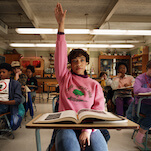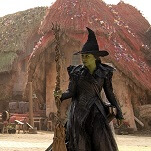Each week, Big Issues focuses on a newly released comic book of significance. This week it’s Deadly Class #13. Written by Rick Remender (Black Science, Low) with art by Wes Craig (Blackhand Comics, T.H.U.N.D.E.R. Agents) and colorist Lee Loughridge (Captain Marvel, Catwoman), this issue is an exhilarating story about the limits of vengeance and the lasting consequences of violence. (This review reveals major plot points.)
When it comes to Rick Remender’s creator-owned Image series, one element gets more attention than anything else: suffering. The transdimensional sci-fi drama Black Science, underwater fantasy tragedy Low, and gritty, punk-inspired Deadly Class are all unified by Remender’s willingness to put his characters through hell, and over the last year and a half, circumstances have gone from bad to worse for all of Remender’s leads. He piles on the obstacles so the triumphs are more meaningful, but as this week’s Deadly Class #13 proves, the victories don’t make the hardships any easier to stomach.
Maria was born in Juárez, Mexico, to two impoverished parents, and when her father stole to feed his family, cartel boss El Alma Del Diablo orphaned Maria, informally adopted her, and raised her to be a killer. She may have been dating her parents’ murderer—El Alma’s son, Chico—but as a student at King’s Dominion Atelier Of The Deadly Arts, Maria was doing fine until Marcus Lopez walked into her life. That’s when everything went to shit. She killed Chico after he discovered her secret affair with Marcus, and now El Alma is in New York City and out for blood. Maria’s life has been one long marathon of suffering that doesn’t appear to have any end in sight, but she finally gets a win in Deadly Class #13 when she uses her finely tuned assassin skills to make her oppressors pay.
At the start of Deadly Class #13, Marcus has just been thrown off a bridge and Maria is handcuffed in the back of El Alma’s car, and these high stakes give the issue a breakneck pace that never lets up. Much of that momentum comes from Wes Craig’s artwork, which builds velocity through panel composition and page design. Compacting the panels on the first page forces the eye to move across the sequence faster than it would if those panels were expanded to fill the full page, and using speed lines and low-to-the-ground camera angles creates the illusion of velocity as Willie races to save his friend with a stolen garbage truck. Compacting the panels also creates a firm ledge between the visuals and the narration running along the right side, which gives the overarching page design a height that reflects the distance Marcus is about to fall.
That first page is all about intensity and speed, which is further accentuated by Lee Loughridge’s high-impact color palette that ramps up the visual tension by pitting cool blue against warm orange. With the turn of the page comes the revelation that Willie saves Marcus just in the nick of time, and the art becomes more relaxed. The contrast is toned down with a palette of purplish reds and blues, and Craig slows down the passage of time for Marcus’ descent, building anticipation for Willie’s dramatic rescue. When Marcus lands in the pile of garbage bags, Craig brings extra force to the fall in a number of ways: the circular border that highlights Marcus while creating a shockwave effect, the “THMP” sound effect with spiked tails that point toward the impact, and the explosion of Rubik’s Cubes on the opposite side of the panel. The truck is also pointing downward, setting up a path of motion for the vehicle as it crashes into the surrounding water.
It’s an exciting start to the issue, and this creative team has made outstanding use of cold opens before the two-page title page and credits, using the bright pink yearbook spread to give readers a brief breather before jumping back into the action. After the Marcus and Willie cold open, the story jumps over to the captured Maria, who is currently being threatened with years of slow torture for killing Chico, but she won’t be listening to El Alma’s words for much longer. She makes a daring smoke-assisted escape, and uses her razor-edged fans to exact vengeance on each of the men that helped ruin her life. “When you killed my family, you summoned a true devil,” Maria says as she slashes through a man twice her size, and the action sequence accentuates that idea by making her a skeletal death goddess surrounded by flames.
One of the best things about Craig’s artwork in this series is that he draws teenagers who look like teenagers, which is very important when telling a story about young people thrown into lives of violence at an early age. Marcus, Willie, and Maria are still growing up; they still have round faces that haven’t lost their baby fat, and their bodies don’t have much muscle definition. They look like people on their way to adulthood, but they still have a while to go before they get there. That youthful appearance helps reinforce that these teenagers are in way over their heads when they find themselves in increasingly dangerous situations, and they’re going to need to grow up fast if they’re going to survive this lifestyle.
Maria’s righteous fury is captured in a vicious four-page scene colored with burning orange and red, making a thin distinction between the smoke from the burning car and the strings of blood trailing from her fans. It’s dynamic and showy, with a heavy element of spectacle that makes Maria look like an incredibly tough badass. But Remender makes a very interesting choice with Maria’s final kill, jumping past the murder of El Alma Del Diablo to show a weary Maria sitting in the bloody aftermath of the mutilation.
There’s no glory in this final kill, the most important kill. There’s no moment of victory. It happens off-panel, but the emotional impact is clear. “After all these years of dreaming about it, it didn’t make anything better,” Maria tells Marcus and Willie when they find her, realizing that vengeance isn’t going to give her any of the relief that she so desperately wants. Craig zooms out for the final panel of this scene to show the three teens together in the middle of a maze of shipping crates, and it’s an evocative image symbolizing the labyrinthine path these young killers are on. The further they walk into the maze of violence, the more difficult it is for them to turn back and escape, and even if they find a way out, the scars of their experiences will stay with them forever.







































